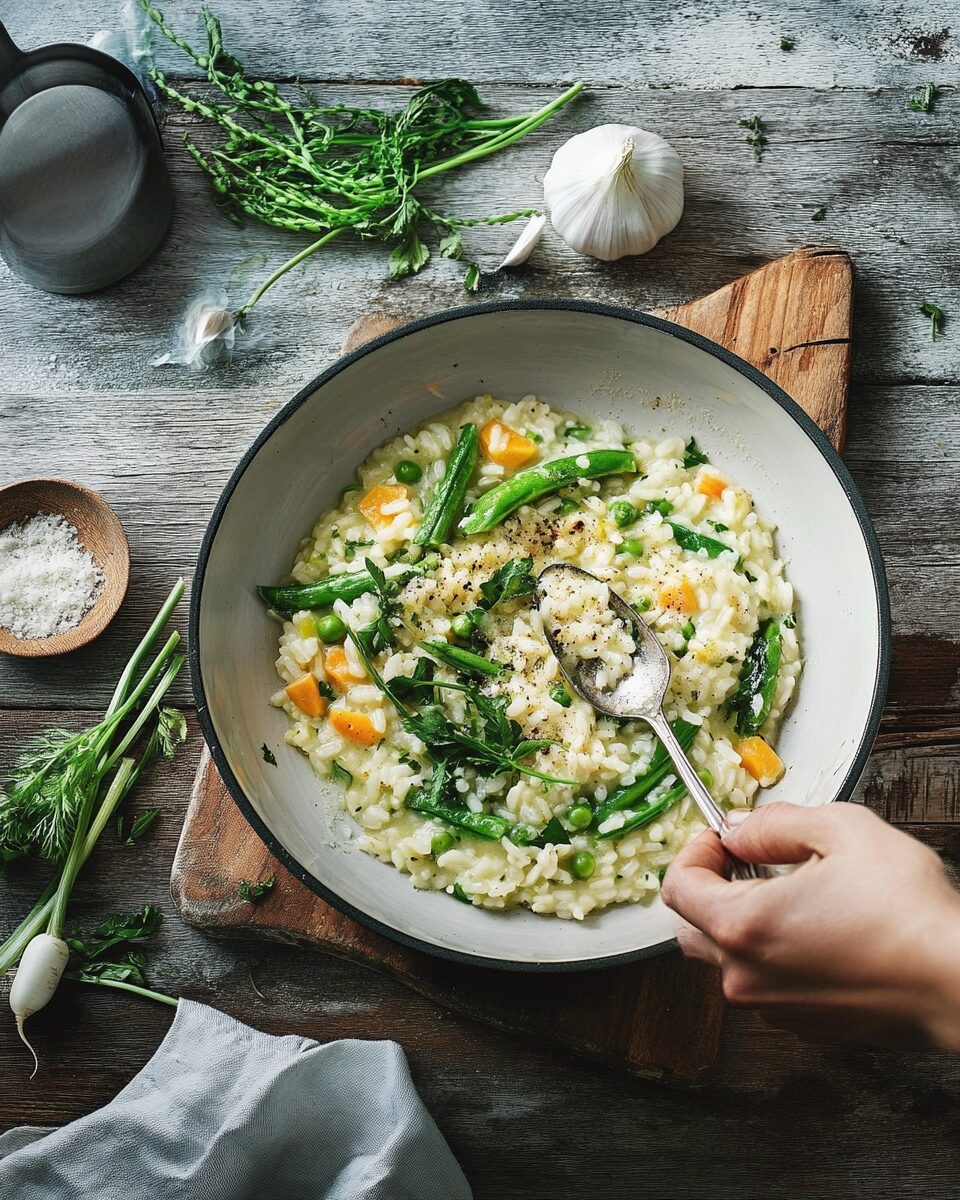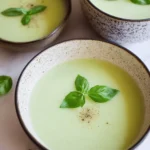A fresh and vibrant risotto, perfect for springtime. Packed with seasonal vegetables like peas, broad beans, and asparagus, it’s a delightful dish for vegetarians, offering both comfort and elegance.
FULL RECIPE
Ingredients
- 300g Carnaroli rice (or risotto rice)
- 150g parmesan, in a wedge
- 20g fresh chives, finely snipped
- 150g shelled broad beans
- 150g asparagus spears
- 200g shelled small peas
- Fistful of ice cubes
- 1 tsp vegetable stock powder
- 1 large shallot, finely chopped
- 3 large spring onions, chopped
- 1 garlic clove, lightly crushed
- 2 tbsp olive oil
- 50g butter
- 125ml dry white wine
- 2 tbsp mascarpone
Directions
- Boil the rice in lightly salted water for 6 minutes, then drain and cool. Chill the rice until ready.
- Blanch the broad beans for 1 minute, then cool and peel the beans from their skins.
- Trim the asparagus and cut into lozenge shapes. Boil water with salt, add asparagus, peas, and broad beans. Simmer for 3 minutes, then transfer to ice water.
- Drain vegetables and save the cooking water. Set vegetables aside.
- Whisk stock powder into the reserved vegetable water and bring to a simmer.
- Sauté shallots, spring onions, and garlic in olive oil until soft.
- Add the rice to the pan with shallots and sauté briefly. Pour in white wine and let it absorb.
- Gradually add the hot stock to the rice, stirring frequently. Once rice is tender, stir in mascarpone, butter, and grated parmesan.
- Add the cooked vegetables and chives, mix gently, and serve with a sprinkle of reserved parmesan.
Nutritional Information
- Calories: 694 kcal
- Fat: 34g
- Saturates: 18g
- Carbs: 69g
- Sugars: 0g
- Fibre: 7g
- Protein: 28g
- Salt: 1.37g
The Nutritional Value of Spring Vegetables
Spring vegetables are an excellent source of essential vitamins and minerals. Asparagus, for example, is rich in vitamin K, folate, and antioxidants, which promote bone health and improve digestion. Broad beans are a good source of plant-based protein, fiber, and iron, making them an ideal addition to a vegetarian or vegan meal. Peas are packed with vitamins A, C, and K, as well as fiber, which supports heart health and digestion.
The Magic of Risotto Rice
The foundation of any great risotto is the rice itself. Carnaroli rice, a medium-grain variety, is commonly used in Italian risotto recipes due to its ability to absorb liquid while retaining its structure. It is known for creating a creamy, velvety texture when cooked slowly with stock. This rice is perfect for soaking up the natural flavors of the vegetables and enhancing the overall richness of the dish.
Why Use Mascarpone in Risotto?
Mascarpone is a soft, creamy cheese that is traditionally used in Italian dishes, adding a luxurious texture and mild flavor. When incorporated into risotto, mascarpone contributes to the creaminess without being as heavy as other cheeses, such as cream cheese or heavy cream. It helps bind the ingredients together, providing a smooth finish to the dish that complements the spring vegetables perfectly.
The Role of Parmesan in Italian Cuisine
Parmesan is an essential ingredient in many Italian dishes, especially risotto. It adds a nutty, umami-rich flavor that balances the sweetness of the spring vegetables. The sharpness of the cheese enhances the creamy texture of the risotto, making each bite deeply satisfying. Freshly grated parmesan is always preferred, as it imparts a fresher, more intense flavor than pre-grated varieties.
Balancing Flavors: The Sweetness of Vegetables and the Richness of Risotto
One of the keys to making this risotto a success is achieving the right balance of flavors. The natural sweetness of the spring vegetables, particularly the peas and broad beans, complements the richness of the creamy risotto base. The addition of fresh herbs like chives further enhances the freshness of the dish, while the slight acidity of the white wine balances the richness and rounds out the flavor profile.
The Importance of Stock in Risotto
The quality of the stock used in risotto is paramount. While vegetable stock powder can be convenient, homemade vegetable stock provides a much richer depth of flavor. Simmering vegetable scraps with herbs and seasonings creates a stock that complements the flavors of the risotto without overpowering them. Using a quality stock ensures that the risotto retains its savory taste throughout the cooking process.
Creating the Perfect Creamy Texture
The hallmark of a great risotto is its creamy consistency. Achieving this requires patience and attention to detail. Stirring the rice constantly and gradually adding hot stock allows the rice to release its natural starch, which thickens the dish and gives it its signature creamy texture. The addition of butter, mascarpone, and parmesan at the end of the cooking process helps to further elevate the richness and smoothness.
The Role of Wine in Risotto
Dry white wine plays a crucial role in risotto preparation. It adds a layer of complexity and a slight acidity that brightens the dish. The wine also helps to deglaze the pan, lifting any caramelized bits of onion or garlic, which adds depth to the final flavor. It’s important to allow the wine to cook off before adding the stock to ensure that the alcohol evaporates, leaving behind only the bright, fruity flavors.
The Science Behind Stirring Risotto
Stirring risotto continuously is essential for achieving the proper texture. The action of stirring helps to release the starches from the rice, which thickens the cooking liquid and creates a creamy consistency. This process also helps the rice absorb the flavors from the stock and vegetables, allowing the dish to come together in a harmonious way. While stirring is essential, it’s also important not to overdo it, as excessive stirring can break the rice and result in a mushy texture.
Why Risotto Should Be Served Immediately
Risotto is best enjoyed immediately after it’s finished cooking. The creamy texture is at its peak, and the flavors are vibrant and fresh. As risotto sits, it continues to absorb the liquid, which can cause it to become thicker and less creamy. If you must wait before serving, consider adding a little extra stock or butter to loosen the risotto before plating.
Pairing Risotto with Wine
A well-paired wine can elevate the flavors of risotto. For this spring vegetable risotto, a crisp, dry white wine such as Sauvignon Blanc or Pinot Grigio complements the fresh, vegetal flavors of the dish. The acidity in these wines cuts through the richness of the risotto, providing a refreshing contrast. A light red wine, such as Pinot Noir, can also work well if you prefer red wine, as its mild tannins won’t overwhelm the delicate flavors of the vegetables.
Serving Suggestions
This risotto makes a perfect main dish for a light dinner, but it can also be served as a side to accompany grilled chicken, fish, or a vegetarian protein like tofu or tempeh. The creamy texture of the risotto complements the savory notes of grilled meats, while the freshness of the spring vegetables provides a beautiful contrast.
The Versatility of Risotto
While this recipe focuses on spring vegetables, risotto is an incredibly versatile dish that can be customized to fit the seasons or personal preferences. In winter, you can use root vegetables such as butternut squash or carrots, while in the summer, you might opt for tomatoes and zucchini. The key to making a great risotto is ensuring that the vegetables complement the creamy rice and that the flavors are balanced.
Cooking Risotto for a Crowd
If you’re cooking risotto for a larger group, it’s easy to scale up the recipe. Simply multiply the ingredients accordingly, and use a large pan to accommodate the increased quantity. While risotto is best made in small batches to ensure the rice cooks evenly, it can be kept warm in a low oven if you need to prepare it in advance.
The Art of Cooking Perfect Risotto
Cooking risotto is as much an art as it is a science. The dish requires constant attention and care, but the end result is well worth the effort. The goal is to cook the rice to a perfect al dente texture, which means it should be tender but still have a slight bite. The risotto should also be creamy without being overly runny or dry. Mastering these techniques will allow you to create a perfect risotto every time.
How to Add Extra Flavor to Your Risotto
To give your risotto a little extra flavor, try incorporating different herbs or spices. Fresh thyme, rosemary, or basil can add depth to the dish, while a sprinkle of lemon zest can brighten the flavors. For a spicy kick, add a dash of red pepper flakes. Experimenting with different flavorings will allow you to create a risotto that’s uniquely yours.
Why Risotto Is a Comforting Dish
Risotto has earned a reputation as a comfort food, thanks to its creamy texture and ability to satisfy without being overly heavy. The process of slow-cooking the rice allows the flavors to meld together, creating a dish that is warm, rich, and deeply satisfying. The addition of fresh vegetables ensures that the dish feels light and refreshing, making it the perfect meal for any occasion.
The History of Risotto
Risotto is a traditional Italian dish that has been enjoyed for centuries. It originated in the northern regions of Italy, particularly in Lombardy and Piedmont, where rice is a staple crop. Over the years, risotto has evolved, with many different variations incorporating a wide range of ingredients. While the basic technique of slow-cooking rice in stock remains the same, risotto has become a versatile dish enjoyed around the world.
Conclusion
This risotto with spring vegetables is a perfect example of how seasonal ingredients can be incorporated into a comforting, elegant dish. The creamy texture, fresh vegetables, and subtle flavors make it a standout choice for a spring dinner. By following the key techniques for cooking risotto and experimenting with different vegetables and seasonings, you can create a dish that’s tailored to your tastes. Whether served as a main course or a side, this risotto is sure to impress with its depth of flavor and satisfying texture.






